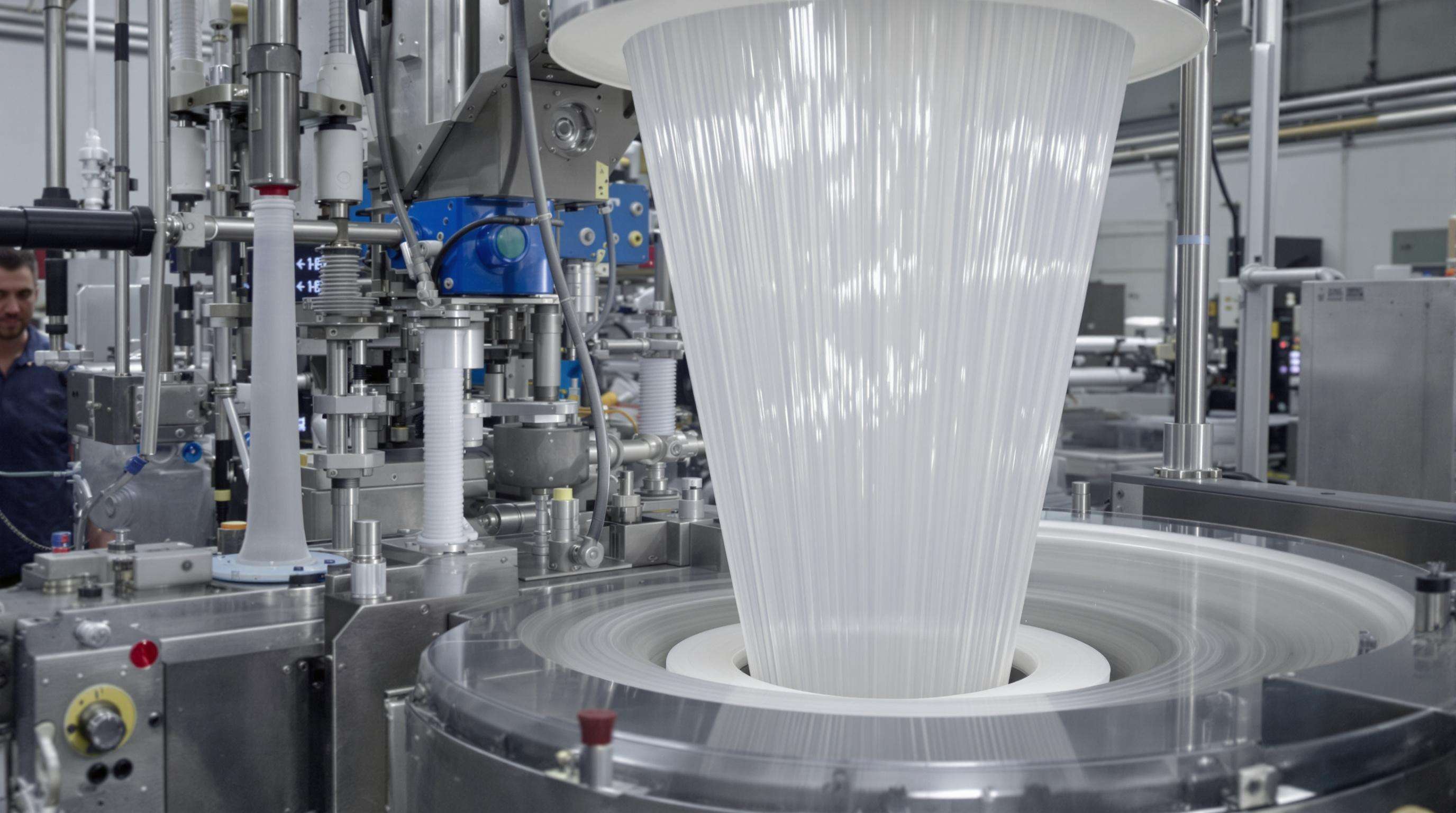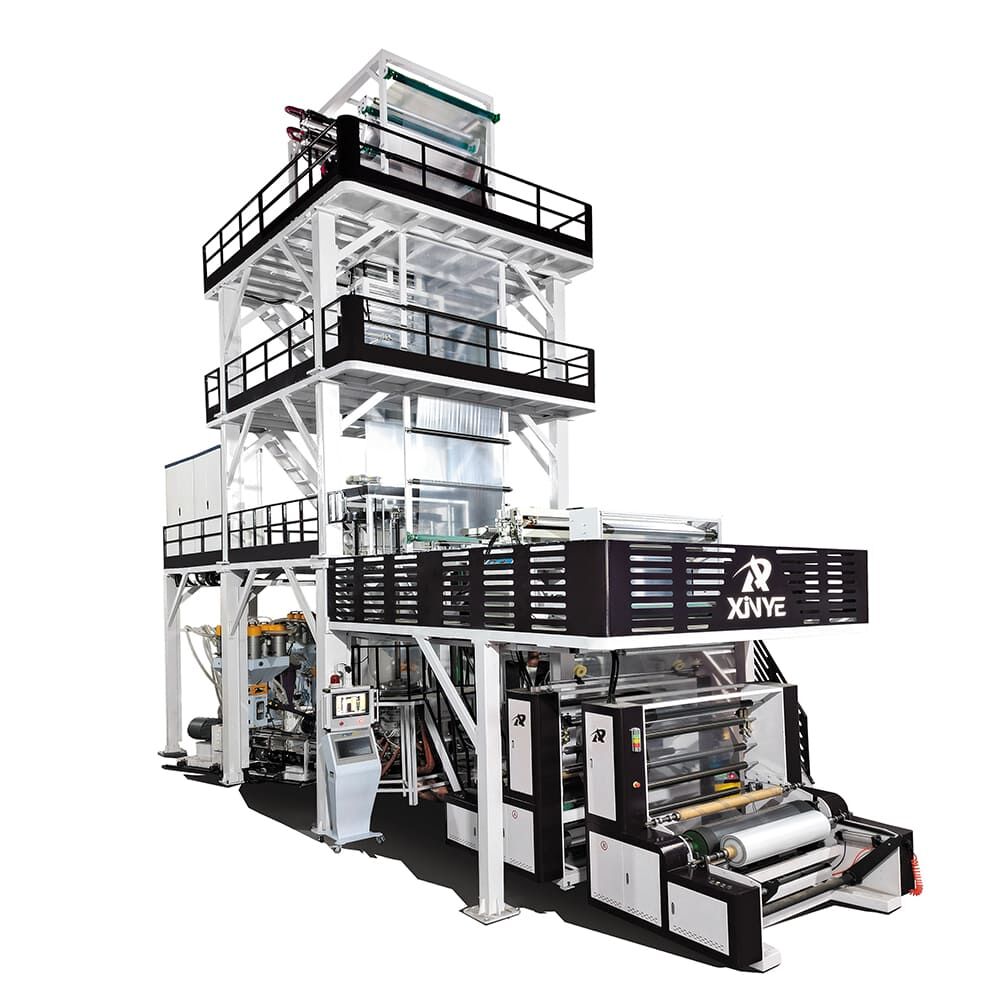Blown film extruder is an important equipment for the production of plastic film, which is widely used in packaging, agriculture, industry and daily necessities. By melting, extruding and blowing plastic raw materials into thin films, the blown film process realizes the complete conversion process from particles to film. So, what is the specific process flow of the blown film extruder? This article will start with the process flow, systematically explain each of its key links and technical control points, and help readers fully understand the blown film extrusion process.
1. What is the Blown Film Extrusion Process?
Blown film extrusion is a thermoplastic plastic molding process, which is mainly suitable for the production of films made of raw materials such as polyethylene (PE) and polypropylene (PP). The plastic is heated and melted by the extruder and extruded from the die head, and expanded into a film under the action of high-pressure gas. At the same time, the entire film making process is completed by traction, cooling and winding.
2. Composition and Structure of Blown Film Extruder
A standard blown film extruder usually includes the following parts:
- Extrusion system (hopper, screw, barrel, heating system)
- Die head system (for forming film embryo)
- Air ring system (cooling and blowing)
- Traction device (controls the thickness and stability of the film)
- Reeling device (completes the collection of film rolls)
- Electronic control system (automatic control of temperature, speed, wind pressure, etc.)
- Each part plays a vital role in the entire process.
3. Process Flow of Blown Film Extruder
3.1 Raw material Preparation and Feeding
The first step in the film blowing process is raw material preparation. Thermoplastic plastic particles are usually used, such as low-density polyethylene (LDPE), high-density polyethylene (HDPE), linear low-density polyethylene (LLDPE) or polypropylene (PP). Masterbatch, antioxidants, lubricants and other additives can be added according to different needs.
These particles are fed into the extruder hopper through an automatic feeding system and fed into the screw heating zone by gravity or a screw feeding device.
3.2 Melting and Plasticizing (Extrusion)
Plastic particles are gradually heated, compressed and melted during the rotation of the screw. The screw and barrel are divided into three areas:
Feeding area: the plastic begins to heat and move forward;
Compression area: the material melts and the pressure increases;
Metering area: ensure that the melt is uniform and ready for extrusion.
The entire process requires strict control of the temperature of each section, generally between 160°C and 250°C (depending on the material), to ensure that the material is fully melted and does not decompose.
3.3 Die Molding (Extrusion Film Embryo)
The molten plastic is evenly extruded and formed into a tubular film embryo through the annular die. The die structure design has a great influence on the uniformity and stability of the film thickness. The die temperature also needs to be controlled within a suitable range, generally slightly higher than the extrusion section, to prevent the material from cooling and agglomerating at the die.
3.4 Inflation Film
Compressed air is injected into the center of the die to blow the film embryo from the original diameter to the target size. The diameter of the film tube formed is called the "blow-up ratio", which is generally between 2:1 and 4:1. By adjusting the internal pressure, cooling speed and traction rate, the thickness and mechanical properties of the film can be controlled.
The inflation process is the key to molding control, and has a significant impact on the tensile properties, transparency and flatness of the film.
3.5 Cooling and Shaping
After the film embryo is blown and formed, it must be quickly cooled to shape to avoid film collapse or unstable bubbles. The commonly used cooling method is air ring cooling (single air ring or double air ring), blowing out normal temperature airflow to surround the film bubble and cool it evenly from the outside.
The cooling efficiency directly affects the production speed and the transparency of the film. High-speed models are mostly equipped with high-efficiency air cooling systems.
3.6 Traction and Folding
The cooled film cylinder is pulled upward by the traction roller and enters the flattening device. The flattening roller presses the cylindrical film into a double-layer flat film, and trims the edges at the same time to prepare for winding. The traction speed is an important parameter for adjusting the film thickness, which is generally coordinated with the extrusion rate.
The traction system must have an automatic tension control function to ensure uniform film tension and stable thickness.
3.7 Winding into Rolls
The final flat film is sent to the winding system and rolled into a film roll at a set speed. Modern film blowing machines are mostly equipped with surface friction or center winding mechanisms and support automatic roll changing functions. Good winding effects can improve the efficiency of subsequent processing steps such as printing and cutting.

4. Critical Factors Affecting Blown Film Quality
4.1 Temperature Control Optimization Techniques
Precise thermal regulation maintains polymer integrity during extrusion. Modern systems utilize multi-zone barrel heating with closed-loop feedback (±1°C accuracy) to prevent degradation. Die temperature gradients must be minimized through segmented heaters.
4.2 Blow-Up Ratio Calculations and Film Properties
The blow-up ratio (BUR) quantifies film expansion as bubble diameter divided by die diameter. Standard BUR values range between 1.5–4.0:
| BUR Range | Tensile Strength | Clarity | Impact Resistance |
|---|---|---|---|
| 1.5-2.5 | Moderate | High | Low |
| 2.5-3.5 | Balanced | Medium | Medium |
| 3.5-4.0 | High | Low | High |
4.3 Industry Paradox: Balancing Production Speed with Crystal Quality
High-speed production often conflicts with crystalline perfection. When line velocities exceed 40m/min, rapid cooling suppresses crystalline formation by 15–30%, weakening barrier properties. Advanced systems resolve this through modulated air rings applying differential cooling.
5. Troubleshooting Blown Film Extruder Operations
5.1 Addressing Film Thickness Variation Issues
Inconsistent film thickness often results from die gap imbalances or cooling irregularities. Die calibration must ensure uniform polymer melt distribution–typically within ±5% tolerance.
5.2 Preventing Bubble Instability Phenomena
Bubble instability stems from material viscosity inconsistencies or air pressure fluctuations. Maintain viscosity stability through resin moisture control (<0.02%) and uniform screw temperatures. Automated pressure regulators should modulate air ring flow within ±2.5 Pa tolerances.
FAQ
1. What is blown film extrusion?
Blown film extrusion is a process that involves the continuous extruding of molten resin to form a bubble that is inflated and stretched into films.
2. What are the benefits of blown film extrusion?
The process allows for the production of custom films from single-layer barrier wraps to complex multi-layer laminates, with tunable mechanical properties.
3. What materials are commonly used in blown film manufacturing?
Common polymers used include polyethylene (LDPE, LLDPE, HDPE), polypropylene, PVC, and specialized biodegradable or engineered polymers like EVOH.
4. How can I prevent bubble instability during extrusion?
Maintaining viscosity stability and ensuring uniform air pressure with automated regulators can help prevent bubble instability phenomena.




